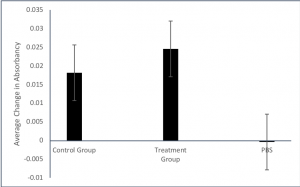1 Immune Priming through Mating in Acheta domesticus
Audrey Coop; Sophia Bond; Katie Sperka; and Kelsie Jackson
Background
Immune priming is when an organism is able to develop a better and faster immune response to a pathogen that it has previously been exposed to. This is similar to how the flu shot contains tiny, deactivated amounts of the flu to help protect you during flu season. The insect immune system was traditionally thought to lack the memory form of defense seen in humans and other vertebrates that allows for immune priming. However, further research has found that when an insect was exposed to a pathogen, its prior experience with similar pathogens could increase its chance of survival.
Transgenerational immune priming is when a parent with increased immunity is able to pass on immunity to its offspring. One mechanism of this transfer of increased immunity to offspring is non genetic through seminal proteins in the male’s ejaculate. It is unknown if this same mechanism, or any other, can transfer increased immunity from a male cricket to its female mate.
One way to determine if a cricket has increased immunity is to perform a lysozyme assay. Lysozymes are enzymes found in blood that damage or kill bacteria. A lysozyme assay is done by mixing the crickets hemolymph (blood) with bacteria. The change in the bacterial population sizes will show the rate of lysozyme activity, thus testing the body’s immunocompetence against bacteria.
Methods
Day 1
We collected all of our crickets, doing our best not to lose any or get too spooked when they jumped at us! After a particularly confusing week that resulted in mixed up samples, we began naming our crickets after celebrities and TV show/movie characters. It helped us keep our data straight, plus it was really fun! We then placed each of the females into their individual containers and started the males’ treatments. We put the control males in their containers, and then gave the treatment males an injection and put them in their containers, as well. The injection was a solution containing lipopolysaccharide bacteria, and we used this as our immune challenge because its use in previous research has created good immune responses while only killing 50% of the crickets that were experimented on. We then left all the crickets in an incubator for 24 hours to allow their immune systems time to respond.
Day 2
We took the crickets out of the incubator and placed the males in their female mates’ containers. This resulted in Beyonce & Jay-Z, Kim and Kanye, Buttercup and Westley, and many other famous couples being reunited. The pairs then went back in the incubator for another 24 hours to give them time to mate.
Day 3
We removed the crickets from the incubator and began drawing a hemolymph sample from each female. (Beyonce’s hemolymph sample was particularly memorable.) After collecting the hemolymph, we mixed the samples with PBS and froze them until the end of all the trials. And of course, cheesy lab selfies are always a must:

Lysozyme Assay
At the end of all our trials, we had 42 hemolymph samples ready to be assayed. We began by thawing our frozen solid hemolymph samples and mixing them with freeze-dried bacteria. We then put all our samples in a well plate and used a spectrophotometer to measure each sample’s bacterial growth curve.
Data Analysis
After we collected our data from the spectrophotometer, we compared the bacterial growth curves between the females who mated with treatment males and the females who mated with control males. Using a data analysis software, we ran tests on our data to see if the difference between our groups was significant or not.
Results & Findings
In our experiment we had 158 crickets, 79 of each sex. However, before the completion of the experiment we had 38 males die and by the end only had 42 females that survived and produced enough hemolymph to be tested. The data from our results of this study came from the growth curve that was produced by the spectrophotometer. We took the value at the end of the curve and subtracted the value at the beginning of the curve to obtain a value for the change in absorbance over time for each sample. We then used that data and ran a t-test of the data and got results showing that there was not a statistically significant difference between the treatment and control groups ( t= -0.56, p= 0.58). We then ran many more tests that weren’t necessary but we were hoping to find a confounding variable to show that we may be wrong and there is a significant difference. We did not find one, every test we ran gave us the same conclusion.

No significant difference between the treatment and control group told us more than just that our expectations were wrong. These results enabled us to determine that immune priming is not passed from the male cricket to the female cricket during the process of mating. While we assumed it would be because of the evolutionary benefits that could be gained from the process, there are potential reasons that this did not occur. Immune priming is very energetically costly so it may not have been worth it for the female to upregulate the systems because the benefits would not have been worth the energetic cost.
Significance
We can see that many species of invertebrates utilize immune priming in an individual’s encounter with pathogens, and priming in their offspring. It is insightful to better understand these adaptations such populations have developed over the generations they have existed. Our experiment set out to test another layer of the immune priming of A. domesticus, and with our result, we know males cannot prime females through mating. Even though this is an ability they lack, the question whether this is an adaptation that could have been advantageous is unclear. While to some extent a female may benefit from the priming, depending on the population and location, she may never be exposed to the same bacteria as the male was. This would make the priming pointless to the survival of the female. Immune priming also has an energetic cost to the male. Being costly to the male and inconsequential to the female, priming across mates may not have been a characteristic that would adaptively develop in an A. domesticus population.
